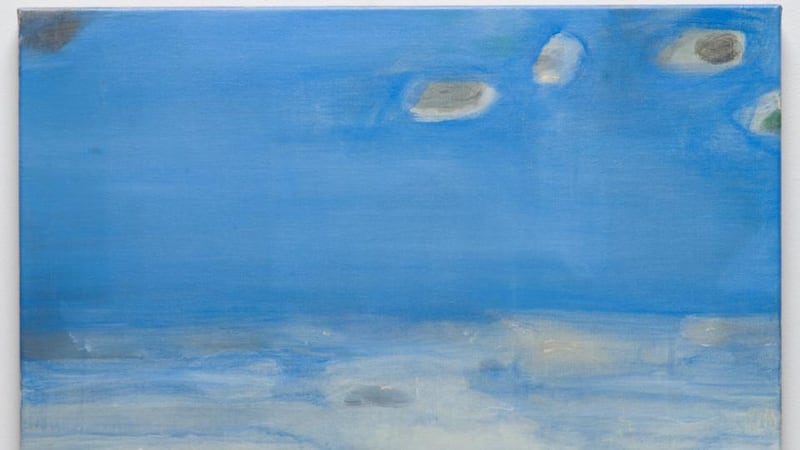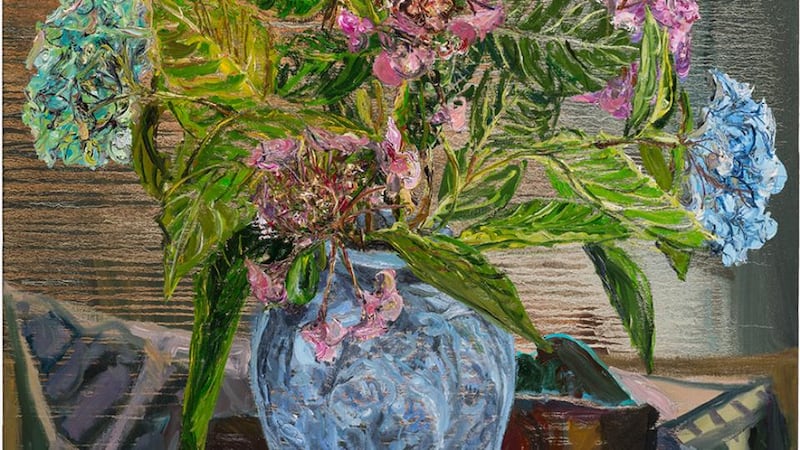A New Quiet – Mark Garry
RHA Gallagher Gallery (Gallery 1)
****


At first glance, you would be forgiven for thinking that Mark Garry's A New Quiet is a misfit in the cavernous space of the RHA's largest gallery. The hangar-like room is sparsely occupied by a number of relatively small-scale pieces, on the walls or freestanding. Each so small, in fact, that it draws you in close to figure out what you're looking at and, in one case, hearing. Given that it's his fifth solo show in the past 12 months, perhaps he had been to the well once too often. But then, depending on your route around the gallery, at some stage you'll probably look upwards and Garry's scheme will click into place.
If you’re already familiar with his work, you might well be looking upwards from the beginning, scouting for one of his trademark rainbows of coloured thread. It’s there, spanning the ceiling at an angle but invisible from many viewpoints until it suddenly, shimmeringly, appears. As with rainbows in nature, the ones Garry makes are physically insubstantial, hardly there, and usually ephemeral. Yet their fleeting beauty is achieved through a great deal of detailed, attentive labour. Those myriad threads are individually strung, and the slow, mindful labour of making is integral to the mood he is trying to generate.
How to describe that mood? Thoughtful, quiet, and something like nurturing. The ideas of tact, care and caring come through consistently in most of what he does. He is disarming in the way that he uses ordinary, everyday materials in straightforward ways, never trying to dazzle with showy virtuosity. But at the same time, the simplicity of appearance he aims for is often achieved not only through assiduous work but also with considerable if understated skill and ingenuity.
A powdered pigment peak behind glass, stratified like a geological diagram, takes the rainbow image and metaphor and manages to suggest the interplay of chance and design, the passage of time, the fragility of life and a lot more. Sequences of very effective, abstract, one-off coloured prints might recall the optimistic, lyrical evocations of dawn skies in paintings by the late Willie McKeown. A birch plywood box invites you to pick up a cello bow and make music that resonates throughout the gallery.
Garry himself makes music as well as visual art. His pared-down aesthetic, which leans towards economy of form and materials, even to the point of conscious impoverishment – dried wild plants, say, and other found bits and pieces – suggests a desire for an alternative to materialistic consumption, for other ways of relating and making. Also distrust – not only a distrust of the art market but the market in a wider sense. That may sound a little wishy-washy, but it's important to say that the work is not. Garry's trump card is the genuine, unpretentious engagement he offers, underpinned by a certain self-critical toughness. He's a dreamer, you might say, but not a self-indulgent one. Until February 22nd, rhagallery.ie
Sandy Island – Tjibbe Hooghiemstra
Hillsboro Fine Art, Dublin
****
Along with fellow Dutch artist Arno Kramer, Tjibbe Hooghiemstra has a particular affinity for Ireland and has consistently worked and shown here for many years. His Sandy Island at Hillsboro is based on an irresistible premise: a Pacific island that appeared in a 19th-century atlas, was accepted as being there, but resisted rediscovery until, in 2012, it was quietly removed "because it didn't exist". It's a Hy-Brasil, a chimera full of imaginative possibility.
Hooghiemstra habitually works on old documents and sheets of paper, things with fragmented and generally obscured histories. He doesn’t set out to solve their mysteries. Rather he taps into their energy and builds on it. It’s a methodology ideally suited to envisioning Sandy Island, an elusive somewhere slightly outside of time and geographical space.
His paintings and works on paper, with their amorphous washes of paint and ink, snatches of handwritten text and obscure patterns, their worn-looking surfaces, hint at and let us glimpse the unobtainable. There isn't a work in his show, on paper or canvas, that would not be pleasant to live with, which is no small achievement. Until February 14th, hillsborofineart.com
Vessels: Nature Morte – Nick Miller
Studio Scene with Elephant – Michael Cullen
RHA Gallagher Gallery, Dublin
****
There's a real edge to Nick Miller's use of the term "Nature Morte" in describing Vessels, his small exhibition of still lifes in the foyer of the RHA. He doesn't do polite arrangements of blossoms at their peak, or serene Morandi pots and vases. Each painting is a solo portrait, a study of a single type of plant or flower, and a vessel that contains it, delivered with raw, insistent clarity. Often the background is fluid and bleached, with traces of pigment that's been diluted and scoured by solvent.
Rather than cut flowers, bred for gentility, tastefulness and longevity, he presents clumps of plants roughly cut from nature and set up in the studio, fiercely present. Almost aglow with dying light, they seem on the point of fading away as we look at them, teetering on the edge.
He's not the only painter to have done something like this – Lovis Corinth and Chaim Soutine are others – but he does it impressively well and with a complete lack of affectation, even artlessly, in the best sense.
The foyer, with its entrances and exits, its desks and traffic, is a difficult location, and you could walk by the paintings without pausing and allowing them time to work, and without realising that they make up a fine exhibition.
The same applies to the atrium beyond, where Michael Cullen's epic 3.5m by 4m canvas Studio Scene with Elephant – Study after Velázquez is installed. Cullen enjoyably reworks the iconic Las Meninas, importing the figure of an elephant, in red, for no particular reason, other than that it came into his head. The animal is gargantuan, but it's woven so tightly into a dense, frenetic composition that you could be forgiven for ignoring the elephant in the room. Until April 26th, rhagallery.ie










